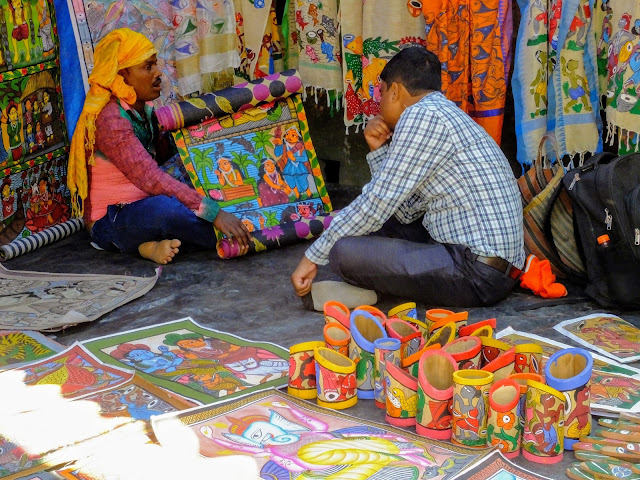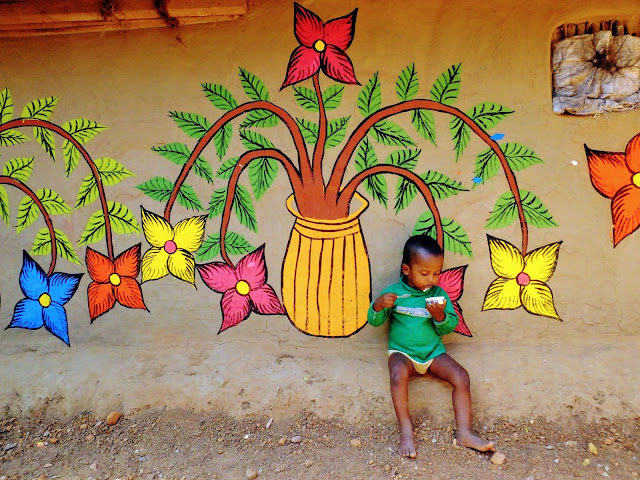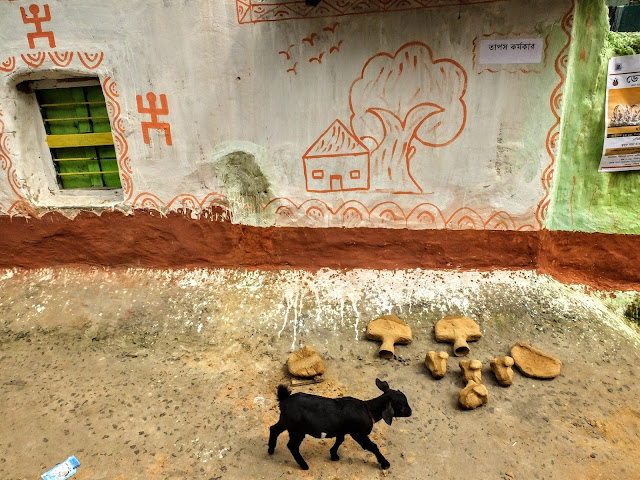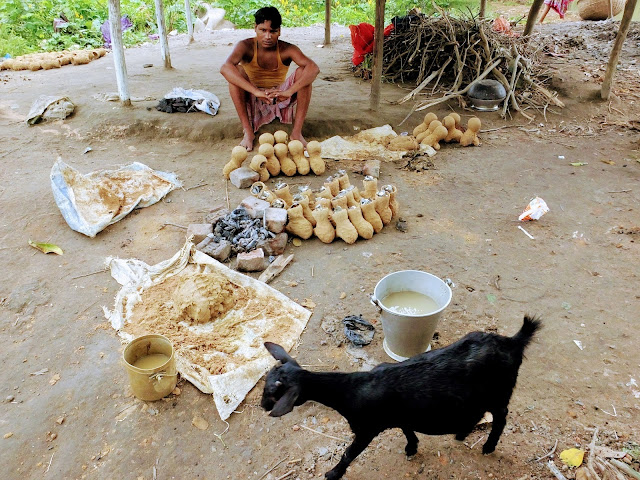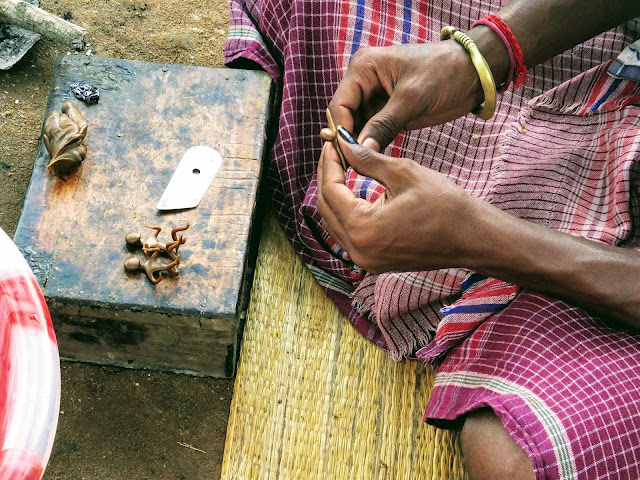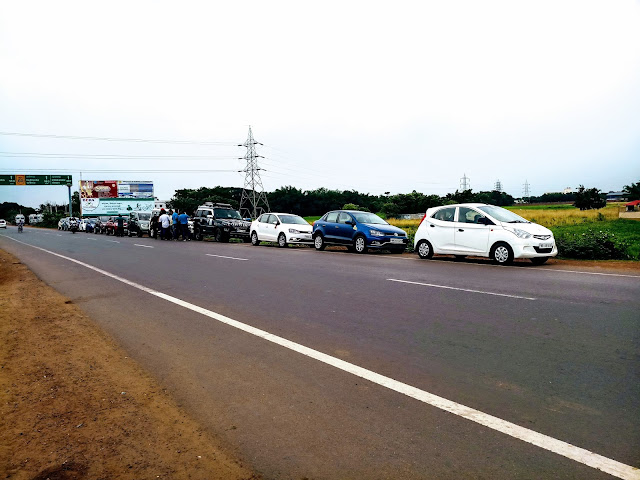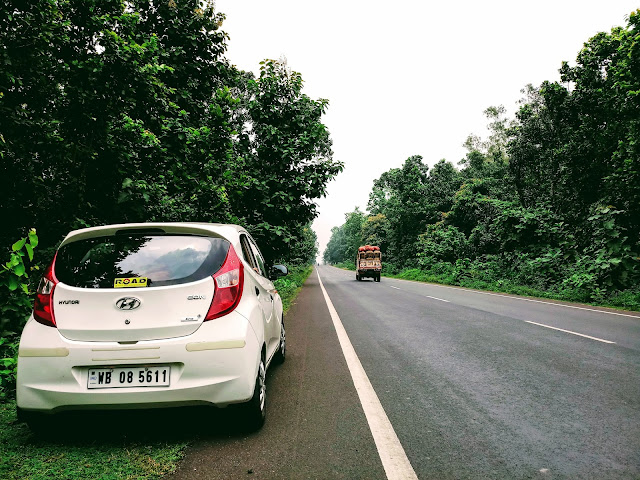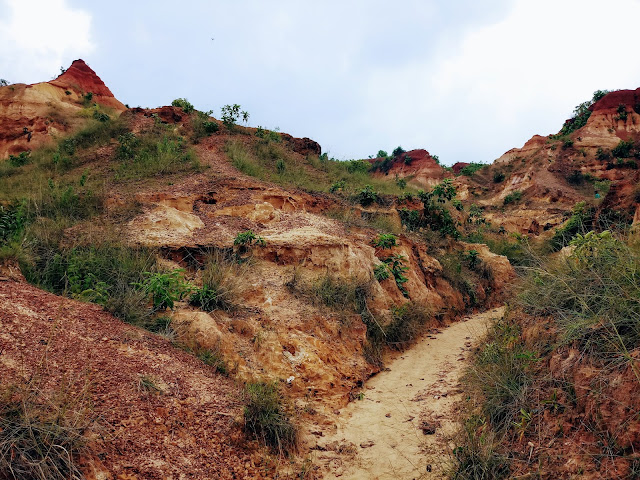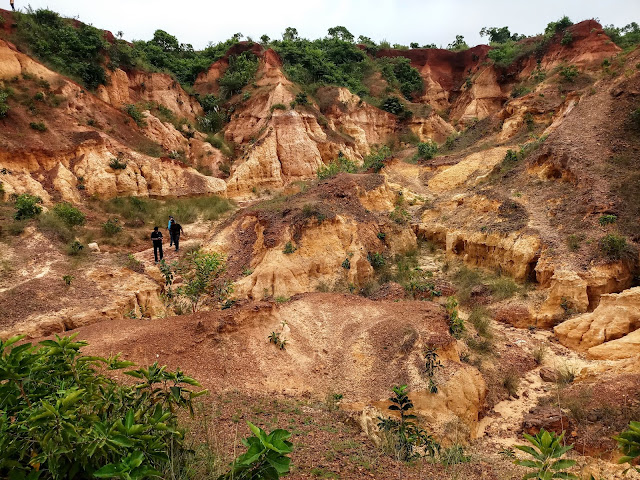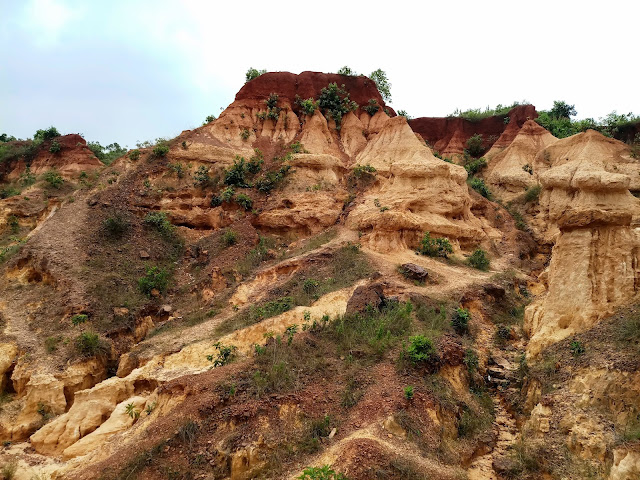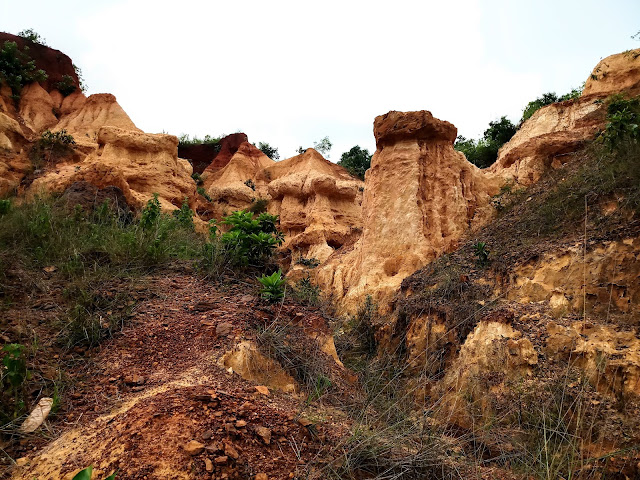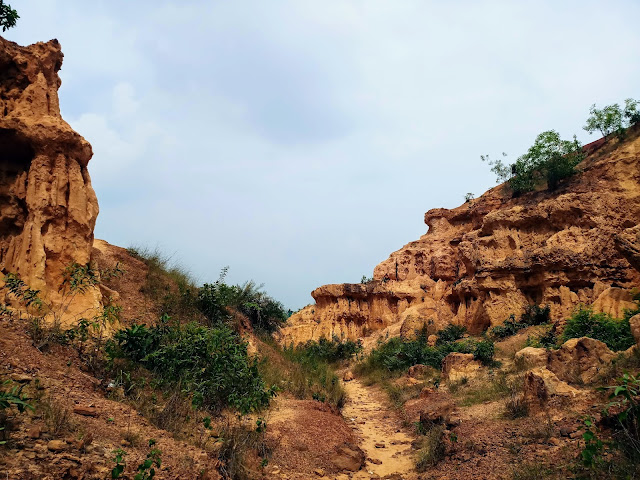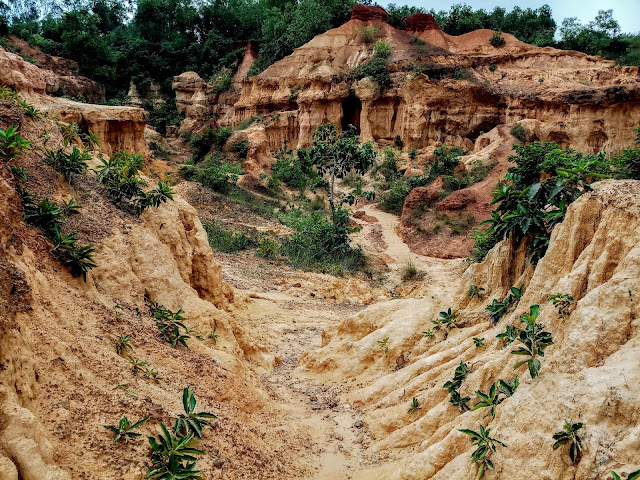মাঝবয়সী মহিলাকে ঘিরে উৎসুক জনতার একটা ছোটোখাটো ভিড়। দু চারজন ফোটোগ্রাফারও আছেন, শাটারের শব্দ হচ্ছে ক্লিক ক্লিক।
মহিলার অবশ্য এইসবে ভ্রুক্ষেপ নেই। তিনি ঘরের দাওয়ায় বসে নিবিষ্ট মনে কাজ করে যাচ্ছেন, ইতস্ততঃ ছড়ান রঙের পাত্র। ক্যানভাসে দক্ষ হাতের তুলির নিপুণ টানে জীবন্ত হয়ে উঠছে ছবি।
ইনি রানী চিত্রকর, ইনি শিল্পী এবং আঁকেন পটচিত্র। শুধু রানী একা নন, পশ্চিম মেদিনীপুরের পিংলা ব্লকের এই নয়া গ্রামের ৭০ টি পরিবারে আছেন প্রায় ২৭০জন শিল্পী। পরিবারের ছেলে বুড়ো মহিলা সবাই মিলে পটচিত্র আঁকেন, এমনকি বাচ্চারাও সোৎসাহে যোগ দেয়। পটশিল্প এই গ্রামের মানুষের রক্তে, বহুযুগ ধরে বংশপরম্পরায় এই শিল্পের ধারা এঁরা বহন করে চলেছেন।
পটচিত্র অতি পুরোন লোকশিল্প। পট্ট হল একটা সংস্কৃত শব্দ যার অর্থ কাপড় বা থান, আর ‘চিত্র’ অর্থাৎ ছবি, এই দুয়ে মিলে এসেছে ‘পটচিত্র’। এই শিল্পের শুরু মনে করা হয় ঊড়িষ্যাতে, পুরী, কোণারক অঞ্চলে। এখানেই রঘুরাজপুর গ্রাম পটশিল্পের জন্য বিখ্যাত। এরপর ধীরে ধীরে পটশিল্প ছড়িয়ে পড়ে বাংলার বিভিন্ন অঞ্চলে, এমনকি বিহার এবং ঝাড়খন্ডের কিছু অংশেও পটশিল্পীদের দেখা পাওয়া যায়।
যাঁরা পটচিত্র আঁকেন তাঁদের বলা হয় পটুয়া। খাস কোলকাতার কালীঘাট অঞ্চলে উনবিংশ শতক থেকেই পট আঁকা হত। এই অঞ্চলেই পটশিল্পীদের বসত ছিল আর তাঁদের আঁকা ছবি কালীঘাটের পট নামেই বিখ্যাত। আজও কালীঘাটের একটা পাড়ার নাম ‘পটুয়াপাড়া’। শৈল্পিক উৎকর্ষতার জন্য কালীঘাটের পটের খ্যাতি ছিল। এতই সুন্দর হত সেসব ছবি যে মনোরম প্রাকৃতিক দৃশ্যকে চলতি কথায় বর্ণনা করতে গিয়ে বলা হত “ঠিক যেন পটে আঁকা ছবি”। আবার সুসজ্জিতা মহিলাদের কিছুটা হয়ত ব্যাঙ্গার্থেই ডাকা হত “পটের বিবি” বলে।
মুলতঃ তিন ধরনের পট বাংলায় দেখা যায়। এর মধ্যে বিশিষ্ট হচ্ছে ‘জড়ানো’ বা ‘গোটানো’ পট, ইংরেজীতে যাকে বলা যেতে পারে স্ক্রোল। নাম শুনেই বোঝা যাচ্ছে ব্যাপারটা অনেকটা ফিল্মের রোলের মত। কিছুটা কমিকসের ব্যাকরণ মেনে গল্প তৈরী করা হয়। লম্বা পটে পর পর পনেরো থেকে কুড়িটা ছবি আঁকা হয় গল্পের ঘটনাক্রম অনুসারে। এর সঙ্গে বাঁধা হয় গান, সেই কাহিনীর বর্ণণা দিয়ে। পটশিল্পী রোল খুলতে থাকেন এবং একেকটি করে ছবি দর্শকদের সামনে মেলে ধরে গানের মাধ্যমে গল্পটির বর্ণনা করে যান। এই গানের বর্ণনার সাধারণতঃ তিনটি ভাগ থাকে, ১)কাহিনী অর্থাৎ মুল গল্প, ২)মাহাত্ব্য, এতে কাহিনীর মহিমা বর্ণনা আর ৩) ভণিতা বা শিল্পীর নিজের পরিচিতি। এইভাবে দর্শককে একটা অডিও ভিসুয়াল অনুভূতির মধ্যে দিয়ে নিয়ে যাওয়ার চেষ্টা হয়। এই ভাবে পট প্রদর্শনকে বলা হয় ‘পট খেলানো’। একসময় পটুয়ারা এই ধরনের পট নিয়ে গ্রামে গ্রামে ঘুরে বেড়াতেন আর পটচিত্র দেখিয়ে আর গান শুনিয়ে মানুষের মনোরঞ্জন করে উপার্জন করতেন।মাঝে মাঝে বিভিন্ন জমিদার বা বিত্তবান মানুষদের বাড়ীতে পুজোপার্বণে পটুয়াদের ডাক পড়ত পট খেলানোর জন্য।
এছাড়াও আছে ‘আড়েলাটাই’ পট আর ‘চৌকোস’ পট। ‘আড়েলাটাই’ পট অর্থাৎ আয়তকার পট আর ‘চৌকোস’ পট হল বর্গক্ষেত্রকার। এই ধরনের পট মুলতঃ ছবি হিসেবেই ঘর সাজানোর কাজে লাগে।
পটুয়ারা পটচিত্র আঁকেন সাধারণতঃ বিভিন্ন সনাতন লোকগাথাকে ভিত্তি করে। বেহুলা লখিন্দর, চন্ডী বা মনসা মঙ্গলের কোন কাহিনী, লক্ষীর পাঁচালী, রাধা কৃষ্ণের লীলাকে ভিত্তি করে বা রামায়ণ মহাভারতের অংশবিশেষ নিয়ে তৈরী হয় পটচিত্রের কাহিনী।আবার সমসাময়িক কোন সামাজিক বিষয়বস্তুর ওপরও আঁকা হয় পট। এছাড়া আড়েলটাই বা চৌকোস পটে দেবদেবী, মানুষজন থেকে শুরু করে জীবজন্তর ছবি সবই আঁকা হয়। ইদানিংকালে পটচিত্র স্বাস্থ্য, শিক্ষা, পরিবেশ সচেতনতা, নারী ও শিশুদের শিক্ষা এবং অধিকার নিয়ে জনশিক্ষামুলক বিভিন্ন প্রচারের হাতিয়ারও হয়ে উঠেছে।
পট সাধারণতঃ তৈরী হয় কাপড় দিয়ে। থানকে মাপমতো কেটে তার সঙ্গে তেঁতুল বিচির আঠা আর চকের গুঁড়ো মিশিয়ে, রোদে শুকিয়ে পট বানানো হয়। এখন কাগজের পটও হয়, সেক্ষেত্রে কাগজের পিছনে কাপড় সেঁটে দেওয়া হয়।
উজ্জ্বল বলিষ্ঠ রঙের ব্যাবহার পটচিত্রের এক বিশেষ বৈশিষ্ট্য। সমস্ত রঙই সম্পুর্ণ প্রাকৃতিক উপাদান থেকে তৈরী করা হয়। এর মধ্যে মাটি, পাথর থেকে শুরু করে বিভিন্ন গাছপাতা, ফুল, সব্জীর নির্যাস সবই আছে। প্রদীপের কালি থেকে তৈরী হয় কালো রঙ, শঙ্খ গুঁড়ো করে হয় সাদা। হলুদ থেকে বানানো হয় হলুদ রং, অপরাজিতা ফুলের নির্যাস থেকে নীল, কালোজামের নির্যাস থেকে বেগুনী, আলতার লাল, ইত্যাদি বহু জিনিস থেকে তৈরী করা হয় রঙ। রঙের সঙ্গে মেশানো হয় বেলের আঠা, এতে পটের ওপর রঙের বাঁধুনী, ঔজ্বল্য আর স্থায়িত্ব বাড়ে।
মুলধারার ছবি আঁকার সময় শিল্পীরা যেমন পেন্সিল বা চারকোল দিয়ে একটা প্রাথমিক ড্রইং করেন পট আঁকার সময় পটশিল্পীরা সেই পদ্ধতি অনুসরণ করেন না। দক্ষ আঙ্গুলের তুলির টানে পটের ওপর একবারেই তৈরী হয় ছবির আউটলাইন। এরপর রঙ দিয়ে ভরাট করা হয়। রঙের মতই শিল্পীরা তুলিও তৈরী করে নেন নিজেরাই। সাধারণতঃ ইঁদুরের লোম দিয়ে তৈরী হয় তুলি, তাতে লাগানো হয় কাঠের হাতল।
আমার মনে হয়েছে পটচিত্র শিল্পীদের শুধু আঁকিয়ে বললে হয়ত কিছুটা অবমুল্যায়ন করা হবে। এঁরা স্বয়ংসম্পুর্ণ এবং বহুমুখী নৈপুণ্যের অধিকারি শিল্পী। এর প্রতিটি ধাপে, পট তৈরী, রঙ এবং তুলি বানানো, ছবি আঁকা, গান বাঁধা এবং সেই গান গেয়ে পট দেখানো, আলাদা আলাদা দক্ষতার প্রয়োজন এবং সেটি এঁরা করায়ত্ত করেছেন। প্রতিটি পর্যায়ে শিল্পীর নিজস্বতার ছোঁয়া পাওয়া যায়।
নয়াগ্রামের শিল্পীরা এখনও বহন করে চলেছেন সেই পুরোন ঐতিহ্য। রাজ্য সরকারের পুরস্কার তো আছেই, এ গ্রামের অনেক শিল্পীরা রাষ্ট্রপতি পুরস্কারও পেয়েছেন। এঁদের বহু কাজই বিভিন্ন সময় বিদেশে প্রদর্শিত এবং প্রশংসিত হয়েছে। পিংলার পটচিত্র AIACA প্রদত্ত ক্রাফটমার্কও পেয়েছে। বাংলার হস্তশিল্পে পিংলা অবশ্যই আমাদের গর্ব।
প্রতি বছরের মতই এই বছরেও ১০ থেকে ১২ই নভেম্বর নয়া গ্রামে বসেছিল পটশিল্প মেলা যা ‘পটমায়া’ নামে পরিচিতি পেয়েছে। এবার এঁদের মেলা অষ্টমবর্ষে পড়ল। উদ্যোগে ২৭০ জন পটশিল্পীদের নিজস্ব সংগঠন “চিত্রতরু”। এছাড়া প্রতি বছরের মতই সঙ্গে আছেন বাংলানাটক ডট কম (www.banglanatak.com) একটি এনজিও, যাঁরা পশ্চিমবঙ্গের বিভিন্ন প্রান্তের লোকশিল্পের পরিচিতি, উন্নয়ন এবং লোকশিল্পের ধারাটি বজায় রাখার জন্য নিরন্তর কাজ করে যাচ্ছেন।
 |
| Workshop in progress for children on making of Patachitra - Naya |
এই তিনটি দিনে নয়া তে যেন রঙের উৎসব। আমি গিয়েছিলাম তৃতীয় অর্থাৎ শেষদিন, রবিবার। এক অসাধারণ অভিজ্ঞতা। গ্রামের প্রতিটি শিল্পীর বাড়ি যেন এক একটি আর্ট গ্যালারী, সবাই পটের পসরা সাজিয়েছেন। দারূণ সুন্দর সব জিনিস। শুধু পট নয়, যুগের সঙ্গে তাল মিলিয়ে পটের চিত্র এখন নেমে এসেছে কাপড়ে। টি শার্ট, কুর্তা, পাঞ্জাবী, ওড়না শাড়ী সবেতেই নিপুণ হাতে ফুটিয়ে তোলা হচ্ছে পটের ছবি। এখানে অবশ্য চিরকালীন প্রাকৃতিক রঙের বদলে ব্যাবহার করা হয় ফেব্রিক পেন্ট। এছাড়াও মাটির ও বাঁশের পেন স্ট্যান্ড, অ্যাশট্রে, গয়নার বাক্স, মায় হাতপাখা আর ছাতাতেও রয়েছে পটচিত্র। অনেক গ্রামের বাড়ীর দেওয়ালেও আঁকা অপুর্ব সুন্দর সব ছবি। নিজেদের ঘরের দাওয়ায় বসে শিল্পীরা ছবি এঁকে চলেছেন আবার বিক্রিবাটা থেকে উৎসাহী দর্শকদের প্রশ্নের উত্তর দেওয়া সবই চলছে সমানতালে। দুই জায়গায় শুনলাম পটের গান। একজায়গায় মনসা মঙ্গল থেকে চাঁদ সদাগরের গল্প শোনাচ্ছিলেন শিল্পী, তার কিছুটা রেকর্ড করতে পেরেছিলাম।
এই গ্রামের প্রায় সব শিল্পীদেরই পদবি হল চিত্রকর। পেশা এবং পদবীর সার্থক মিল বলা যেতে পারে। আরো একটি ব্যাপার, এই গ্রামের শিল্পীরা প্রায় সবাই ধর্মে মুসলমান। কিন্তু পটচিত্রে এঁরা লোকায়ত থেকে হিন্দু সব দেবদেবী এবং মানুষের চরিত্র সবকিছুই ফুটিয়ে তোলেন। ইসলামে পৌত্তলিকতা এবং শিল্পের মাধ্যমে কোনরকম ফিগারেটিভ প্রদর্শন নিষিদ্ধ। কিন্তু কোন ধর্মীয় প্রভাব এই শিল্পীদের মধ্যে পড়েনি বা কখনো এঁদের শিল্পসৃষ্টির পথে বাধা হয়ে দাঁড়ায়নি। এঁরা আপন খেয়ালে এবং ভালোবেসে বহুপ্রজন্মচর্চিত এই শিল্পের ধারাকে বয়ে নিয়ে চলেছেন। আজ এই বিভেদের যুগে এ এক আশ্চর্য সংহতির বীজমন্ত্র। এখনও এই গ্রামে আজানের সুর মিলে যায় পটুয়াদের মনসামঙ্গলের গানের সুরে।
ছোট্ট ছুটির অবসরে চলে যেতে পারেন নয়া গ্রাম। শিল্পীদের দরজা সারাবছরই অতিথিদের জন্য খোলা, চলে বিকিকিনির মেলা। সামনে থেকে দেখতে পারেন এঁদের কাজ। ইচ্ছামত কেনাকাটাও করতে পারবেন।ঘর সাজানোর জন্য পট বা প্রিয়জনের জন্য শাড়ী বা অন্য কিছু, এছাড়াও টুকিটাকি বহু জিনিস।
নয়া কলকাতার খুব কাছেই, মাত্র ১৩০ কিলোমিটার দূরে। একদিনেই ঘুরে আসতে পারবেন। ট্রেনে গেলে হাওড়া থেকে চড়ে নামুন দক্ষিণপুর্ব রেল সেকশানের বালিচক স্টেশানে। সেখান থেকে বাস বা অটোতে নয়া গ্রাম চার কিলোমিটার মতো।
গাড়িতে এলে কলকাতা থেকে এন-এইচ সিক্স বা মুম্বাই রোড হয়ে কোলাঘাট ব্রীজ পেরিয়ে সোজা ডেবরা। ডেবরার মোড়ের কাছে ফ্লাইওভার না ধরে সার্ভিস রোড ধরে এগিয়ে বাঁ দিকে ঘুরে সোজা বেশ কিছুটা এসে বালিচক স্টেশনের কাছে রেল গেট পেরোনর পর কিছুদুর গিয়েই মুন্ডমারীর মোড়। সেখান থেকে আবার বাঁদিকে ঘুরে কিলোমিটার তিনেক গেলেই রাস্তার বাঁ দিকে পড়বে নয়া। দেখবেন কাছাকাছি দুটো পেট্রল পাম্প আছে রাস্তার দুপাশে।
যদি চান থাকার বন্দোবস্তও হয়ে যাবে। থাকার আর অনান্য খবরাখবরের জন্য যোগাযোগ করুন এখানে।
চিত্রতরু
গ্রাম এবং পোস্ট নয়া,
জেলা পশ্চিম মেদিনীপুর,
পিন – ৭২১ ১৪০
ফোনঃ ৯৭৩৩৫২১৩৩৫


